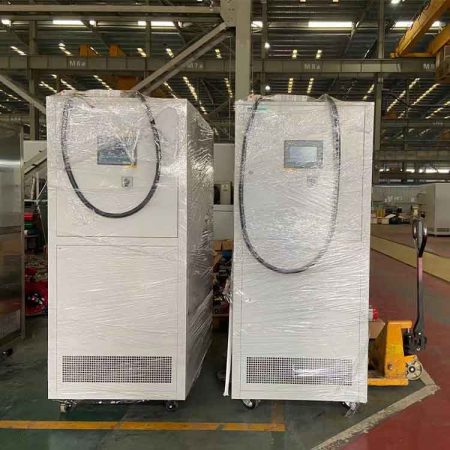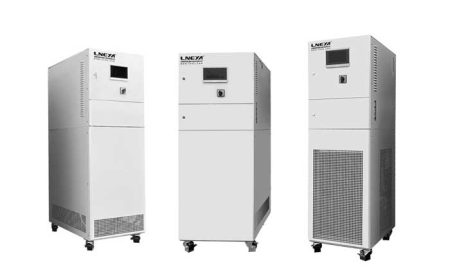Circulating Cooling System
Kontaktieren Sie uns noch heute für die perfekte Lösung zur Temperaturkontrolle
The four major components of the circulating cooling system: compressor, condenser, throttling mechanism, and evaporator.
The functions of the four major components of the circulating cooling system
Kompressor-adiabatic compression function: compresses medium-low temperature and low-pressure refrigerant into high-temperature and high-pressure superheated steam.
Verflüssiger – Condensation (heat release): The high-temperature and high-pressure gaseous refrigerant dissipates heat through heat exchange, and the refrigerant becomes a medium-high-temperature and high-pressure liquid.
Die throttling mechanism has a throttling effect: through the throttling effect, the medium-high temperature and high-pressure liquid refrigerant is turned into a low-temperature and low-pressure gas-liquid two-phase refrigerant.
Verdampfer-evaporation effect (heat absorption): The refrigerant absorbs heat when flowing through the evaporator, and turns the refrigerant into a medium-low-temperature and low-pressure gaseous refrigerant through the action of the heat exchanger.

The role of other components of the circulating cooling system
High and low pressure controller: The high and low pressure protector of the refrigeration system. When the high pressure is too high or the low pressure is too low, an alarm signal is generated.
Oil separator: Separates the refrigerant and refrigeration oil in the exhaust pipe. The refrigerant continues to enter the condenser along the pipeline, and the separated refrigeration oil returns to the compressor through the oil return pipe.
Condensing pressure regulating valve: It plays the role of regulating the condensing pressure. It can prevent the condensing pressure from being too high and causing high-pressure protection. It can also prevent the condensing pressure from being too low and causing insufficient pressure difference between the front and rear of the throttling structure. Of course, not every system needs this valve.
Reservoir: Stores excess refrigerant in the refrigeration system.
Under low-temperature conditions, the refrigerant circulating in the refrigeration system will be much lower than the refrigerant under normal temperature conditions. If there is no liquid reservoir at this time, the excess refrigerant will be stored in the condenser, accounting for most of the replacement time. thermal area.
Ball valve: A manually opened and closed valve that can cut off the refrigerant circuit.
01) It can be used to close the refrigerant in the condenser or liquid receiver when replacing the filter or thermal expansion valve, so that there is no need to drain the refrigerant of the entire system.
02) Add refrigerant to the system: When debugging a new machine, all the refrigerant cannot be added in the shutdown state. At this time, you need to turn on the compressor and suck the refrigerant into the system through the suction pipe of the compressor. However, many normal temperature During working conditions, the pressure of the evaporator is actually not low or even higher than the pressure of the refrigerant tank, and the refrigerant cannot be added either. Then at this time we can close the ball valve and switch the refrigerant coming from the condensing side, and the compressor can suck the refrigerant into the system.
03) Recycle refrigerant
Drying filter: As the name suggests, it plays the role of removing moisture and filtering impurities in the refrigeration system. This filter is placed in front of the expansion valve to prevent impurities from entering the valve core and blocking the expansion valve.
Solenoid valve: An electric component that can cut off the refrigeration pipeline manually or automatically; it also plays a great role in the refrigeration system.
Evaporation pressure regulating valve: mainly prevents the evaporation pressure from being too high, causing compressor failure.
Crankcase pressure regulating valve: It can also be called suction pressure regulating valve to prevent excessive suction pressure from causing excessive load on the compressor and damaging the compressor.
The evaporation pressure regulating valve and crankcase pressure regulating valve are not required by everyone’s system. Generally, in small systems, we can use a thermal expansion valve with MOP function instead.
Suction filter: Installed on the suction pipe to filter impurities in the refrigeration system to prevent them from entering the compressor and causing compressor failure.
Wir bieten die Entwicklung und Herstellung kompletter Temperaturkontrollsysteme an. Von Standardmodellen bis zu kompletten kundenspezifischen Produkten bis hin zu 900 Tonnen. Wir haben uns auf den Kundenservice spezialisiert und sind bestrebt, jedem Kunden zu helfen, das optimale Temperaturkontrollsystem für seinen spezifischen Bedarf zu finden.
Wir bieten maßgeschneiderte Lösungen, die nicht dem Standard entsprechen. Es sind sowohl einzelne Kühlaggregate als auch kombinierte Kühl- und Heizaggregate erhältlich.
E-Mail: info@lneya.com WeChat ID: +8615251628237 WhatsApp: +86 17851209193

Rückkühler / Umwälzkühler
Die Kältemaschine kann in verschiedenen Industrien und Labors eingesetzt werden und unterstützt kundenspezifische Designs.
| Temperaturbereich | Serie -25°C ~ +30°C | -45°C ~ +30°C Reihe | Serie -60°C ~ -20°C | Serie -80°C ~ -20°C | Serie -120°C ~ -70°C | ||||
| Kühlleistung | 0,8 ~ 30kW | 0,75 ~ 12kW | 0,4 ~ 6kW | 0,2 ~ 6kW | 0,3 ~ 5kW | ||||
| Hinweis: Jeder Temperaturbereich von -150℃ ~ +350℃ und jede Kühlleistung kann angepasst werden | |||||||||
 Kaltwassersätze / Kleinkaltwassersätze
Kaltwassersätze / Kleinkaltwassersätze
Die Kältemaschine kann in verschiedenen Industrien und Labors eingesetzt werden und unterstützt kundenspezifische Designs.
| Temperaturbereich | -18°C ~ +30°C | +5°C ~ +35°C Reihe | |||||||
| Kühlleistung | 0,35 ~ 0,9kW | 1,8 ~ 50kW | |||||||
| Hinweis: Jeder Temperaturbereich von -150℃ ~ +350℃ und jede Kühlleistung kann angepasst werden | |||||||||

Niedertemperatur-Kühlgeräte
Wir haben uns auf die Herstellung von Niedertemperaturkältemaschinen mit einem Temperaturregelbereich von bis zu -150°C spezialisiert, die den Kühlbedarf verschiedener Branchen decken.
| Temperaturbereich | Serie -25°C ~ -5°C | Serie -45°C ~ -10°C | Serie -60°C ~ -10°C | Serie -80°C ~ -30°C | Serie -110°C ~ -50°C | Serie -150°C ~ -110°C | |||
| Kühlleistung | 12 ~ 360kW | 6 ~ 180kW | 6 ~ 180kW | 4 ~ 180kW | 2 ~ 120kW | 2,5 ~ 11kW | |||
| Hinweis: Jeder Temperaturbereich von -150℃ ~ +350℃ und jede Kühlleistung kann angepasst werden | |||||||||

Hochtemperatur-Kühlgeräte
Die Kältemaschine kann in verschiedenen Industrien und Labors eingesetzt werden und unterstützt kundenspezifische Designs.
| Temperaturbereich | +5°C ~ +40°C | -25°C ~ +40°C | -45°C ~ +40°C | -80°C ~ +80°C | -100°C ~ +80°C | ||||
| Kühlleistung | 6 ~ 40kW | 2 ~ 15kW | 1 ~ 8kW | 0,6 ~ 3kW | 1,5 ~ 3kW | ||||
| Hinweis: Jeder Temperaturbereich von -150℃ ~ +350℃ und jede Kühlleistung kann angepasst werden | |||||||||
Kühlen und Heizen Kaltwassersätze

Kühlen und Heizen Kaltwassersätze
Temperaturregelbereich: -120°C bis +350°C
Kühl- und Heizungsthermostate, die in verschiedenen Industriezweigen weit verbreitet sind.
| Temperaturbereich | Serie -10 ~ +150°C | Serie -25 ~ +200°C | Serie -25 ~ +300°C | Serie -45 ~ +250°C | Serie -45 ~ +300°C | Serie -60 ~ +250°C | Serie -60 ~ +300°C | Serie -70 ~ +250°C | Serie -80 ~ +250°C | Serie -90 ~ +250°C | Serie -100 ~ +100°C | ||
| Kühlleistung | 1,5 ~ 15kW | 1 ~ 200kW | 1 ~ 200kW | 0,45 ~ 200kW | 0,9 ~ 25kW | 0,25 ~ 60kW | 0,75 ~ 25kW | 0,4 ~ 15kW | 0,3 ~ 80kW | 0,2 ~ 80kW | 0,45 ~ 80kW | ||
| Hinweis: Jeder Temperaturbereich von -150℃ ~ +350℃ und jede Kühlleistung kann angepasst werden | |||||||||||||

Kühlgeräte mit Rücklaufheizung
Temperaturregelbereich: -45°C bis +250°C
| Temperaturbereich | Serie -25°C ~ +200°C | Serie -45°C ~ +250°C | |||||||
| Kühlleistung | 1 ~ 15kW | 0,25 ~ 15kW | |||||||
| Hinweis: Jeder Temperaturbereich von -150℃ ~ +350℃ und jede Kühlleistung kann angepasst werden | |||||||||
 LNEYA
LNEYA
 简体中文
简体中文


















































































